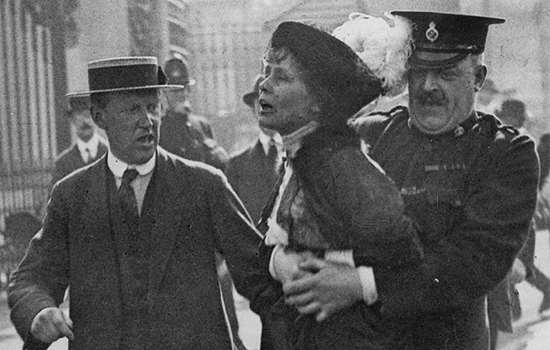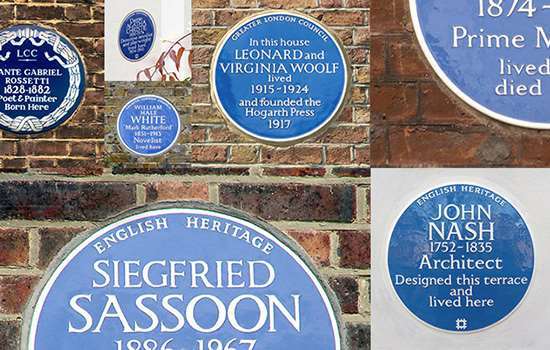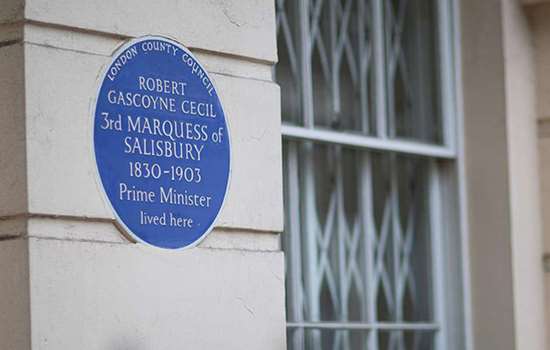CONAN DOYLE, Sir Arthur (1859–1930)
Plaque erected in 1973 by Greater London Council at 12 Tennison Road, South Norwood, London, SE25 5RT, London Borough of Croydon
All images © English Heritage
Profession
Author
Category
Literature
Inscription
SIR ARTHUR CONAN DOYLE 1859–1930 Creator of Sherlock Holmes lived here 1891–1894
Material
Ceramic
Sir Arthur Conan Doyle was a writer and doctor best known for creating the brilliant fictional detective Sherlock Holmes. A blue plaque marks the spot in South Norwood where Conan Doyle lived in 1891–4.
Early Career, Tennison Road and Sherlock Holmes
Arthur Ignatius Conan Doyle was the eldest of nine children born in Edinburgh to a Scottish father and an Irish mother. He studied medicine at Edinburgh University and was greatly influenced by his professor, Joseph Bell, a master of deduction who was able to diagnose patients with remarkable speed and accuracy. After graduating, he established a successful medical practice in Southsea, Hampshire.
In spring 1891 Conan Doyle moved to London with his wife, Louise, and their daughter, Mary. Initially intending to continue his medical practice, he was increasingly devoted to writing, a long-held passion. He had already come to attention with the novel A Study in Scarlet (1887) and its sequel The Sign of the Four (1890), which introduced Sherlock Holmes and his somewhat hapless assistant, Dr Watson.
By the summer of 1891, the family had moved to 12 Tennison Road in South Norwood which Conan Doyle described as ‘a prettily-built and modest-looking red-brick residence’ dating from just a few years earlier.
He turned to writing full-time and, working from his study – to the left of the front door as you look at the house – he wrote 18 Holmes adventures, including ‘The Boscombe Valley Mystery’ (1891), ‘The Speckled Band’ (1892) and ‘The Musgrave Ritual’ (1893). The short stories had been transferred to the newly established sixpenny Strand Magazine and were immensely popular.
The house at Tennison Road may have provided the setting – in ‘a big modern villa of staring brick’ – for the murder in ‘The Adventure of the Norwood Builder’ (1903).
Death of Holmes and Move
As the fame of Sherlock Holmes grew, Conan Doyle became uneasy at the prospect of being pigeonholed. He decided to put an end to the detective in ‘The Final Problem’ (December 1893); to do so he invented a nemesis for Holmes: the evil Professor Moriarty.
Conan Doyle’s wife Louise suffered from tuberculosis, prompting several visits to Switzerland. They left Tennison Road in 1894 to move to the supposedly better climate of Hindhead, Surrey. Conan Doyle had a house built – Undershaw – to his own specifications. Later, with his second wife, Jean, he lived in Crowborough, East Sussex.
Conan Doyle wrote a series of historical novels, including The White Company (1891) and Sir Nigel (1906), which he considered his best work. Later came a series of stories featuring Professor Challenger, an hot-tempered scientist. Nothing, however, matched Holmes for popularity and under pressure from his publisher, he reprised his most successful creation in 1903, and subsequently. The last collection, The Case-Book of Sherlock Holmes, appeared in 1927.
Politics and Reform
Conan Doyle stood unsuccessfully as a Liberal Unionist parliamentary candidate for Edinburgh Central in 1900 and for Hawick in 1906. Despite this, after 1916 he supported Irish Home Rule.
He supported women’s rights in professional life and believed that women who paid taxes should have the vote, but was a vehement critic of militant suffragette action. In 1909, he became president of the Divorce Law Reform Union, which eventually resulted in the Matrimonial Causes Act 1923. The Act decreed that adultery by either a husband or a wife could be the sole ground for a divorce: prior to that, a woman had to prove additional cause.
Conan Doyle was active in exposing serious miscarriages of justice, including that of the mixed race Birmingham solicitor George Edalji, whose wrongful conviction for the mutilation of animals in 1906 he put down to ‘colour hatred’. Later he helped to quash the murder conviction of Oscar Slater, who was of German-Jewish origin. His opposition to the Ku Klux Klan and sympathy for interracial marriage were suggested in ‘The Five Orange Pips’ and ‘The Yellow Face’. But, as was common in the writing of that time, he often used racial stereotypes to describe characters from China, India and elsewhere.
Conan Doyle served as a doctor during the controversial South African War and defended British policy in his works The Great Boer War (1900) and The War in South Africa (1902).
During the First World War he was a military correspondent and historian, producing The British Campaign in France and Flanders (1920). In a more critical vein, The Crime of the Congo (1909) was an attack on the brutal exploitation of the Congo Free State by King Leopold II of Belgium.
Psychic Phenomena
Conan Doyle’s interest in psychic phenomena was strengthened during the war, and by the deaths of his first wife and his son Kingsley. In 1918 he published The New Revelation, the first of several works on spiritualism which would occupy his latter years. The Vital Message (1919) proposed that in the coming world, etheric bodies – a spiritual form that in some traditions is said to connect the physical body to a higher plane – will be devoid of ‘all birthmarks, deformities, blindness and other imperfections … a perfect body waits for each’. In the wake of the First World War this may have counted as utopian thinking, but such words take on a more sinister ring from today’s perspective.
Conan Doyle’s other interests included cricket, which he played to a good level, and boxing – his knowledge of which he drew on for the novel Rodney Stone (1896).
Conan Doyle died at home in Sussex in 1930. His original entry in the Dictionary of National Biography, published seven years later, stated that his novels ‘had no great claim to literary distinction’. Time has not vindicated that assessment, though Conan Doyle’s fears that he might be remembered only for one character were better grounded – as illustrated by the descriptor on the plaque: ‘Creator of Sherlock Holmes’.
The Holmes stories remain popular and have since spawned numerous films – notably the series that starred Basil Rathbone – and TV adaptations too.
Further Reading
- Douglas Kerr, Conan Doyle: Writing, Profession, and Practice (Oxford, 2013)
- John Lamond, with an epilogue by Lady Conan Doyle, Arthur Conan Doyle: A Memoir (London, 1931)
- Owen Dudley Edwards, ‘Doyle, Sir Arthur Ignatius Conan (1859–1930)’, Oxford Dictionary of National Biography (2017) (access with a UK public library card)
- John Sutherland, Sherlock Holmes, the world's most famous literary detective,The British Library (15 March 2014) (accessed 9 Nov 2020)


